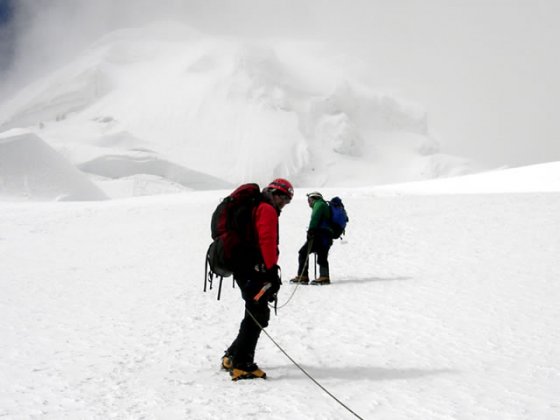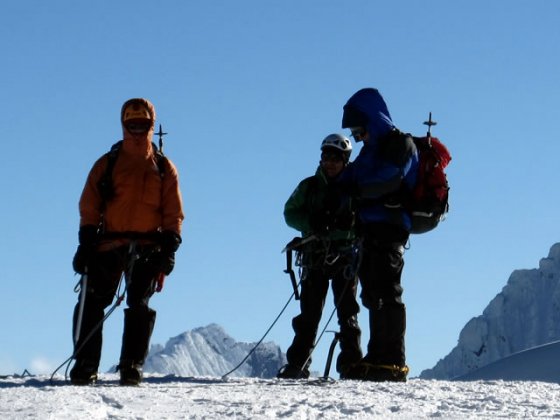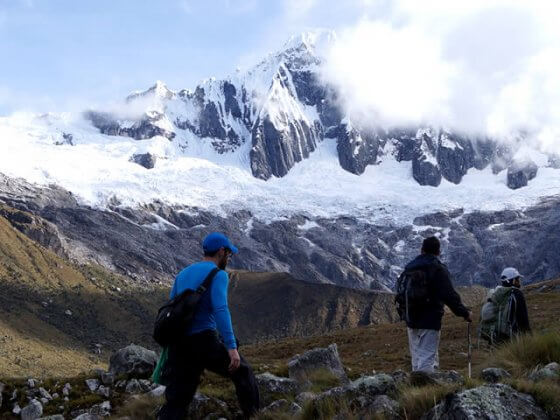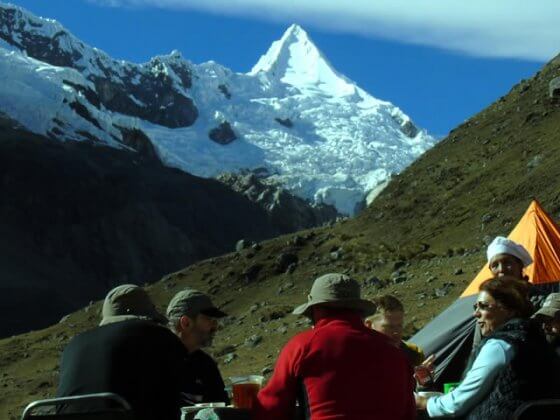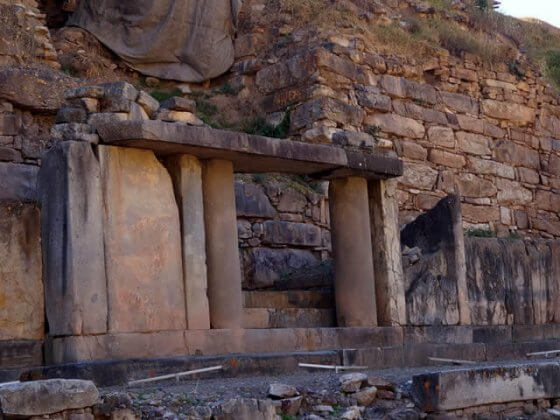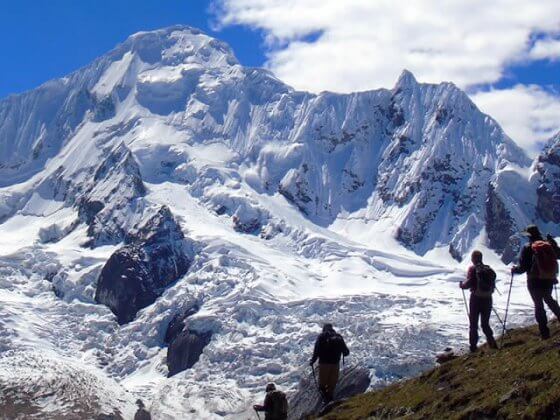Huaraz
Known as the “Capital of International Friendship”, Huaraz is the capital of the department of Ancash and is located at 3090 MASL, 408 km north of the city of Lima on the banks of the Santa River between the Cordilleras Blanca and Negra.
The city of Huaraz is an obligatory destination for lovers of adventure sports in Peru. This is an ideal place to base oneself for treks and climbs in the Coldilleras Blanca, Huayhuash, and Raura. Huaraz enjoys a mild and seasonally dry climate with a rainy season between the months of October and April. In these months the temperature varies between 20 and 25ºC. The dry season is from May to September and is known as the “Andean Summer”. The average temperatures in these months range between 10 and 20ºC and can be almost completely without precipitation.
There are two ways to travel to Huaraz: one is via the north Pan-American highway for several hours and then diverting eastward into the mountains at Pativilca (408 km for the whole route); the other is to take one of the 50 minute flights from Lima to Anta.
From Huaraz we can visit the following places:
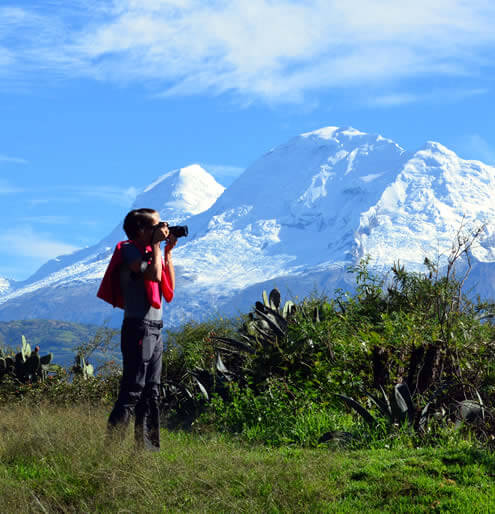
- The Cordillera Blanca
This range comprises a section of the Peruvian Andes and is the world’s tallest tropical mountain range. It includes Huascaran (6768 m), the world’s highest peak within the tropics and Alpamayo (5947 m), considered by many to be the most beautiful mountain in the world.
The Cordillera Blanca extends some 180 km from the northwest to the south in the department of Ancash and measures 28 km at its widest point. It contains three dozen peaks taller than 6000 m and dozens more snowy peaks taller than 5700 m. Some of the best-known mountains are: Huascaran (6768 m), Alpamayo (5947 m), Huandoy (four summits- 6395, 6356, 6166 and 6070 m), Chacraraju (two summits- 6112 and 6001 m), Artesonraju (6025 m), and Taulliraju (5850 m). Many of the peaks are visible from the Santa Cruz/Llanganuco route. In the central part of the Cordillera Blanca can be found the peaks such as: Taulliraju (6034 m), Chinchey (6222 m), Palcaraju (6274 m), Cayesh (5721 m), and Huantsán (6395 m). There are also smaller mountains like Pastoruri (5420 m), which is significant because in its valley exists the rare Puya Raimondi, which has largest inflorescence of any plant on earth. These glaciated peaks are the source of the rivers and streams that water the Conchucos region and the Huaylas Valley.
The Cordillera Blanca holds great biodiversity with 112 species of birds registered, between residents and migrants, and 779 plant species pertaining to 104 families and 304 genera. Without a doubt, the Cordillera Blanca is synonymous with natural beauty.
- The Cordillera Huayhuash
The Cordillera Huayhuash, located 110 km south of Huaraz and 50 km southeast of the Cordillera Blanca, is 30 km long, with seven of its summits rising to more than 6000 m. In this range you will find the second highest mountain in Peru, Yerupaja (6634 m after Huascarán 6768 m) and Siula Grande (6344 m), which was made famous by Joe Simpson in his book, “Touching the Void”. Some other famous peaks include: Rondoy (5780 m), Hirishanca (6094 m), Toro (5945 m), Siula Grande (6344 m), Sarapo (6127 m), Carnicero (5960 m), and Trapecio (5644 m).
Like the Cordillera Blanca, the Huayhuash has a great diversity of flora and fauna. According to studies done by Roberto Arevalo of the Mountain Institute, there have been identified in the Huayhuash 272 species of plants in 148 genera and 55 families. There are also 61 species of birds, 14 mammals, and two species each of amphibians and fish. In 2002 the Ministry of Agriculture through INRENA (National Institute of Natural Resources) declared the Huayhuash a protected zone in which the development of certain commercial activities, including mineral extraction, is prohibited.
- The Chavín de Huantar Archeological Complex
The Chavín de Huantar Archeological Complex is located 110 km from the city of Huaraz at 3180 MASL and is located at the confluence of the Rivers Puchka and Mosna near the beginning of the Conchucos valleys in the Department of Ancash. These constructions were built in the time of the Chavín culture between the 10th and 4th centuries BCE. The complex is built around a central plaza with structures containing subterranean internal galleries and works of great importance like the Lanzón, a five meter tall monolith carved from stone with anthropomorphic motifs (birds, snakes, and cats). Protruding from the back wall of the exterior of the main structure there remain two tenon heads that guard the complex.
The Chavín de Huantar temple is considered one of the oldest and most important archeological sites in Peru. It was declared a “World Heritage Site” by UNESCO in 1985.
- The Huaylas valley
This is an intermontane valley situated between the Cordilleras Blanca and Negra. It runs approximately 180 km from the village of Conococha in the south to the Cañón del Pato (Duck Canyon) in the north. Through this valley courses the fast-flowing Santa River, which is fed by melt water from the glaciers in the Cordillera Blanca bringing life to its banks as it goes.
All the way down the Huaylas Valley are beautiful spots beyond number with spectacular views of the Cordillera Blanca, lakes, rivers, and streams. There are many archeological sites such as: Wilkawain, Cueva de Guitarreros, Honcopampa, Tumshukaiko, etc. Here we also find various picturesque towns like: Catac, Recuay, Huaraz, Tarica, Carhuaz, Mancos, Yungay, Caraz, etc.
The Huaylas valley is without a doubt an excellent place for adventure sports and to experience the countryside with trekking, camping, horseback riding, mountain biking, rock and ice climbing, paragliding, and more all available.
April Through October are the best months to visit; November through March is the rainy season.
- Sechin Archeological Complex
The Sechin Archeological Complex is located 5 km to the southeast of Casma and is attributed to the Sechin culture, which appeared 1800 BCE. It was discovered by the Peruvian archeologist Julio César Tello and is approximately 3500 years old. Its seven constructions cover about five hectares of land; six are made of stone and mud mortar and one made of conical adobe bricks also set in mud mortar. The exterior of the structure is covered with large decorated slabs showing motifs of combat and conquest in a particularly macabre fashion.



